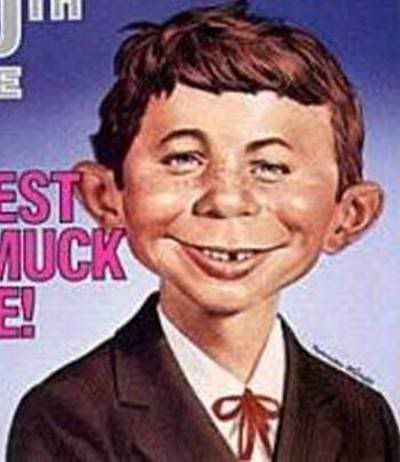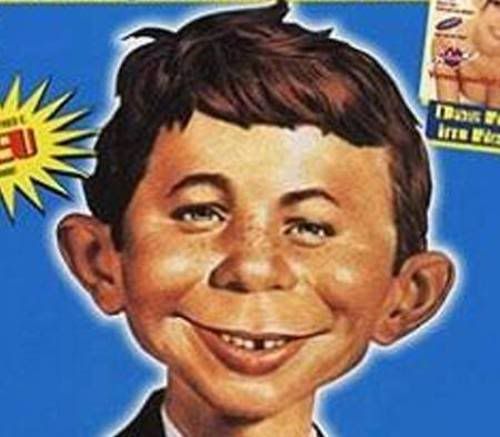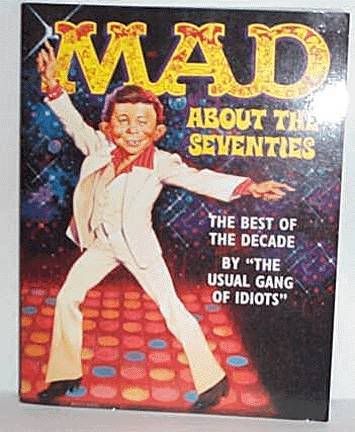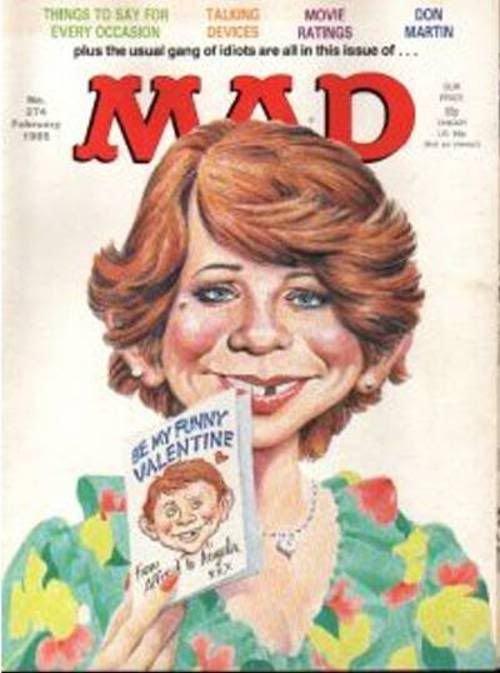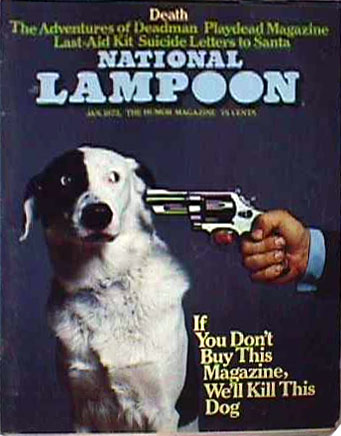Skip to comments.
THE PICTURES THAT HORRIFIED AMERICA ( Unpatriotic Tool To Get At Kids )
CNN ^
| MAY 08.08
| By Todd Leopold
Posted on 05/08/2008 10:30:12 PM PDT by fight_truth_decay
click here to read article
Navigation: use the links below to view more comments.
first 1-20, 21-27 next last
.....1954 elections returned control of Congress to the Democrats, Kefauver was given the chairmanship of the juvenile delinquency subcommittee. Under his direction, the committee wrote its report on the comic book industry, issued in March 1955, and continued its examination of violence and sex in the mass media with hearings on film and television. It was during the course of the Senate investigation of organized crime that Kefauver first turned his attention to comic books, gathering information on the comic book industry from a survey sent to judges of juvenile and family courts, probation officers, court psychiatrists, public officials, social workers, comic book publishers, cartoonists, and officers of national organizations who were interested in the issue. That survey was sent out in August 1950.
The Post Office Department was given an extensive list of comic book titles, along with names of publishers, writers, and artists, to investigate.
The hearings opened with a statement from Senator Hendrickson, who outlined the purpose and goals of the committee. The hearings would be concerned only with crime and horror comic books, acknowledging that authorities agreed the majority of comic books were “as harmless as soda pop.” He argued that freedom of the press was not at issue and that his committee did not intend to become “blue-nosed censors.” And he claimed the committee approached the issue with no preconceptions; rather, the task of the committee was to determine whether crime and horror comic books produced juvenile delinquency.
The two witnesses whose testimony received the most attention were Wertham and Gaines. These two personified the struggle over comic books in postwar America.
Wertham played a central role in the comic book controversy, beginning with his attack on comic books in 1948. His credentials were impressive, and he was quickly embraced as a leading expert in the field of comics and juvenile delinquency and was often asked to testify in cases in state and federal courts. Wertham’s book summarizing his case against comics, Seduction of the Innocent, was published just before the Senate began its hearings on comics, and it was this material on which Wertham based his testimony.
Gaines, inherited his comics publishing business after his father died in a boating accident in 1947, was the most outspoken of the comic book publishers, and the media frequently interviewed him when they needed a quote from an industry representative. Gaines’s company, called Educational Comics in 1947, was publishing “kiddie comics” with names like "Bouncy Bunny in the Friendly Forest". Gaines began to introduce new titles, and by the end of 1949 was publishing six love, crime, and western comics. In 1950, he changed the company name to Entertaining Comics and issued what became known as the “New Trend” comics, launching such horror titles as The Crypt of Terror and The Vault of Horror. The new titles sold well, and within a year E.C.’s financial problems were over. It was these titles that attracted the attention of critics such as Wertham and, as a result, the subcommittee.
Wertham testified on the afternoon of the first day of the hearings, followed by Gaines. Gaines originally had been scheduled to appear in the morning, but other witnesses apparently ran on longer than expected, pushing Gaines’ testimony until after lunch. After the committee reconvened, however, Wertham appeared to testify, and the committee moved him ahead of Gaines. Gaines later contended that the postponement of his appearance adversely affected his testimony. According to his biographer, Gaines was taking diet pills, and as the medication begain to wear off, fatigue set in. Gaines recalled: “At the beginning, I felt I was really going to fix those bastards, but as time went on I could feel myself fading away...They were pelting me with questions and I couldn’t locate the answers.”
For Wertham, it made “no difference whether the locale is western, or Superman or space ship or horror, if a girl is raped she is raped whether it is in a space ship or on the prairie.” Wertham singled Superman out, noting that the comic books aroused in children “phantasies [sic] of sadistic joy in seeing other people punished over and over again while you yourself remain immune.” Wertham called it the “Superman complex.” Much of his testimony was anecdotal evidence of the harm of comic book reading drawn from his book or from articles, with Wertham describing how children imitated violence they read about in comic books. For example, he told the senators of this incident in New York State: “Some time ago some boys attacked another boy and they twisted his arm so viciously that it broke in two places, and, just like in a comic book, the bone came through the skin.”
The testimony of the first witness, committee staffer Clendenen, set the tone of the hearings. He began his presentation by showing examples of the crime and horror comics under investigation by the committee.
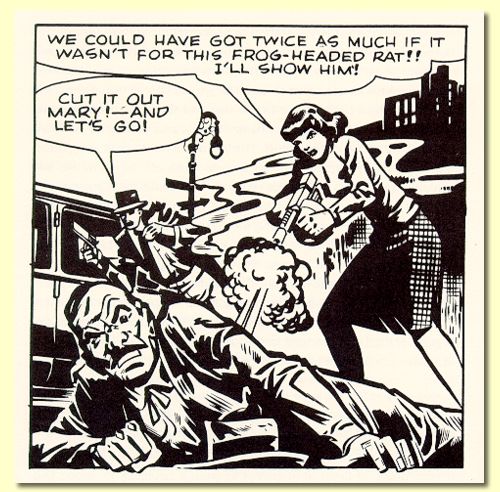
This story is a good example ot the type of crime comics that critics found objectionable. The lead character, Mary Fenner, is extremely violent and kills without hesitation or remorse. Her victims are innocent, unarmed men who are foolish enough to get in her way. There is always a big monetary payoff for the crime, and the gang members escape unscathed (until the end of the story). The police, too, are violent men who do not hesitate to shoot the fleeing robbers in the back and then gloat. This story, like many, justifies the violence by making sure the criminals are punished in the end. But Mary’s fate is buried in a caption, without any illustration, and the end of the story, finishing with, “She breathed out her life in a California gas chamber--discovering, but too late--that crime must pay the penalty!”
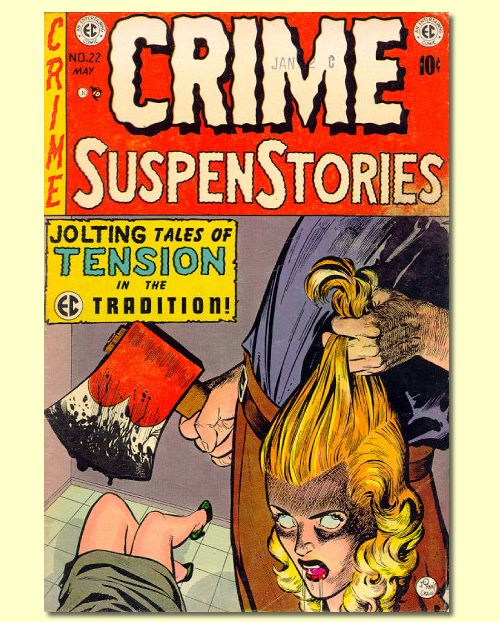

Chief Counsel Herbert Hannoch asked if it did children any good to read such stories, Gaines replied: “I don’t think it does them a bit of good, but I don’t think it does them a bit of harm, either.” He maintained throughout the hearings that comics were harmless entertainment.
Wertham clarified his stand on the effects of comics, stating, "Now, I don’t say, and I have never said, and I don’t believe it, that the comic-book factor alone makes a child do anything,” he said. Other environmental factors were at work. But, he added, he had isolated comics as one factor of delinquency and his was “not a minority report.” Underlining where he differed from his colleagues, he contended the kind of child affected was “primarily the normal child...the most morbid children that we have seen are the ones who are less affected by comic books because they are wrapped up in their own phantasies [sic].”
Film historians have observed that the heyday of film noir was in the late '40s, and it wasn't long before Brando, James Dean, Elvis Presley and many others were busting boundaries in other genres.
Gaines was a part of that, Hajdu observes. There was one comic, a humor book, he had protected. He made it a magazine to save it from the Comics Code Authority and refused to accept advertising.
In time, the magazine became one of the most influential publications of the 20th century, inspiring generations to question authority and mocking the pieties of politics, religion and popular culture.
It was called Mad.
CrimeBoss
To: fight_truth_decay
There was a good scholarly work done on the comic book phenomenon. It is titled Comic Book Nation.
2
posted on
05/08/2008 10:35:11 PM PDT
by
Army Air Corps
(Four fried chickens and a coke)
Comment #3 Removed by Moderator
To: fight_truth_decay
ahh! old school radio and comics.


4
posted on
05/08/2008 10:46:15 PM PDT
by
robomatik
((wine plug: renascentvineyards.com cabernet sauvignon, riesling, and merlot))
To: Army Air Corps
This was to Poster #3, but gone now.........(waves) Code of Decency
Although the committee recommended no federal regulation of comic books, publishers felt the chill of potential censorship. They (the committee) banded together and devised their own code of decency.
"If crime is depicted, it shall be as a sordid and unpleasant activity."
"Divorce shall not be treated humorously nor represented as desirable."
"Passion shall never be treated in such a way as to stimulate the lower and baser emotions."
When the code took effect in late 1954, the vast majority of crime and horror comic books disappeared from newsstands. But by then America's children were becoming addicted to a new and far more sinister medium: television.
WallStreetJournal
To: fight_truth_decay
6
posted on
05/08/2008 10:50:10 PM PDT
by
Ciexyz
Correction: They (the committee) banded together and devised their own code of decency. Twas the comic book publishers themselves. Ironically committee seem to fit, therefore, an easy mistake!!!
To: fight_truth_decay
***When the code took effect in late 1954, the vast majority of crime and horror comic books disappeared from newsstands. But by then America’s children were becoming addicted to a new and far more sinister medium: television.***
But when John and Bobby Kennedy were shot the MSM blamed...guns, TV crime and western shows, movie violence, and...Comic books!
Guns were “registered”, imports of WWII bolt action rifles banned, Tv shows dumbed down to kiddie shows (I’ll never forgive them to what they did to Gunsmoke), comic books dumbed down for while, and the Hollywood moguls proclaimed they would police themselves.
HOT D@MN! Censorship is gone! Nudity and violence ruled in Hollywood from that day forward.
Then we saw a new more “adult” rated comic books hit the stands...
To: fight_truth_decay
9
posted on
05/08/2008 11:11:00 PM PDT
by
skimask
(Never argue with an idiot, they will drag you down to their level and beat you with experience)
To: fight_truth_decay
10
posted on
05/08/2008 11:11:45 PM PDT
by
skimask
(Never argue with an idiot, they will drag you down to their level and beat you with experience)
To: fight_truth_decay
Interesting bit of history. Sort of like the print version of Quentin Tarentino. Funny to read of blowhard senators up in arms about it. Some things never change.
Let's not ever let go of our freedom. We individuals have a role to play.
11
posted on
05/09/2008 12:58:10 AM PDT
by
Huck
("Real" conservatives support OBAMA in 08 (that's how you know Im not a real conservative))
To: fight_truth_decay
12
posted on
05/09/2008 2:15:59 AM PDT
by
GodBlessRonaldReagan
(Wakka-ding-hoy - battle cry of the Plexus Rangers!)
To: fight_truth_decay
And right now every Lib is dying that Ironman made 104 Million in it’s first weekend. Guess who the bad guys are? Not white male Christians but Arab looking dudes from Afganistan.
Next is Hulk, with the Ironman crossover. With as big as Ironman is, Hulk will explode into the box office.
Then Thor and (dum, dum, dum) Captain America. Finally, the Avengers in 2011.
Anyone who has seen Iromman knows that it is pro-America. They have the obligatory, “bad big business” theme, but it doesn’t last long as Tony Stark (playboy and drunk) makes the Ironman suit to fight evil and they show that the business isn’t bad, Jeff Bridges is.
It’s the 50’s all over again with Marvel running the show. The Libs have to be peeing their pants.
13
posted on
05/09/2008 5:54:29 AM PDT
by
netmilsmom
(I am very mad at Disney. Give me my James Marsden song!!!!!)
To: skimask
Isn’t that Dennis Kuchinich?
14
posted on
05/09/2008 5:56:22 AM PDT
by
netmilsmom
(I am very mad at Disney. Give me my James Marsden song!!!!!)
To: netmilsmom
Before there were Superhero comic books there were Funny Books because inside were reprints of comic strips from newspapers, much like the Garfield or Calvin and Hobbs strips. The idea for this came from George Janosik, Harry Wildenberg, and a salesman named M.C. Gaines. They got a contract with the McNaught and McClure Syndicates to reprint some of their comic strips. M.C. Gaines saw what a success these comics were, and continued printing more comics.
Famous Funnies: a Carnival of Comics was the second M.C. Gaines comic book. Printed in 1933, it was 64 pages with a 10 cent price. It was the first retail comic that was distributed to the public. It was distributed only through chain department stores. M.C. Gaines and Eastern Color Printing worked together on creating it and got George Delacorte of Dell Publishing to publish the book. After the first issue, Dell Publishing (not seeing any profit) decided to stop publishing the comic. Eastern Color Printing then decided to publish the book themselves and got newsstand distribution through the American News Company

While Popeye didn't go out and fight crime, he did eat his spinich and displayed some 'above average' feats of human strength while fighting his nemises Bluto. Popeye was created by Elzie Segar and first appeared in a strip called Thimble Theater in 1929.
"I yam what I yam."
"I fight to the finich 'cause I eat me Spinach; I'm Popeye the Sailor Man" Toot, toot!
Note: One of Popeye's, writes the author (Lessons in Life, Love and Culture from Popeye, Brutus, Olive Oyl and Wimpy), redeeming qualities was he was not bright enough to get too far off track (a "sailor" depicted as not too bright). Often it was even clear that Popeye 's nemesis Brutus was in fact cleverer albeit he always seemed to lose on principle and didn't have the secret weapon spinach.
To: fight_truth_decay
I don’t think that Popeye was depicted as a Sailor to show that he was dumb. He was just dumb. As were Wimpy, Olive and any other character in Popeye. We have cartoons from the 30s. Everyone is dumb in Popeye.
Unlike today where it’s intentional.
16
posted on
05/09/2008 6:46:05 AM PDT
by
netmilsmom
(I am very mad at Disney. Give me my James Marsden song!!!!!)
To: fight_truth_decay
What in the heck did poster #3 write that got him/her/it pulled?
17
posted on
05/09/2008 8:49:14 AM PDT
by
Army Air Corps
(Four fried chickens and a coke)
To: skimask
MAD Magazine. A staple of mine in the mid-70’s!
18
posted on
05/09/2008 8:51:30 AM PDT
by
Lou L
To: Lou L
To: skimask
God, I used to LOVE Mad Magazine when I was a kid. Don Martin’s cartoons were some of the funniest cartoons I’ve ever seen!
20
posted on
05/09/2008 8:56:41 AM PDT
by
reagan_fanatic
(Average White Conservative)
Navigation: use the links below to view more comments.
first 1-20, 21-27 next last
Disclaimer:
Opinions posted on Free Republic are those of the individual
posters and do not necessarily represent the opinion of Free Republic or its
management. All materials posted herein are protected by copyright law and the
exemption for fair use of copyrighted works.
FreeRepublic.com is powered by software copyright 2000-2008 John Robinson





